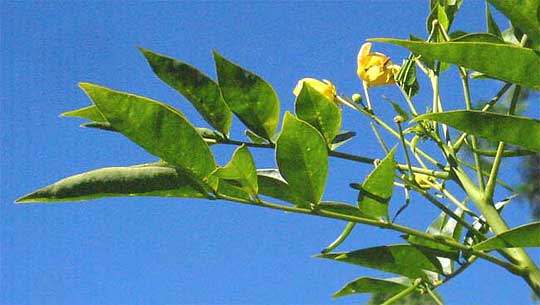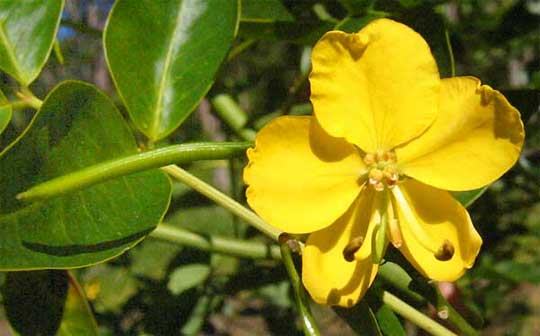Excerpts from Jim Conrad's
Naturalist Newsletter
from the December 17, 2007 Newsletter issued from Yerba Buena Clinic just outside Pueblo Nuevo Solistahuacan, Chiapas, MÉXICO
about 1740 meters in elevation, ± LAT. 17° 11' 27"N, LONG. -92° 53' 35"W
SENNAS
Most places in Mexico, including the Yucatan, Querétaro and here, you're likely to see Sennas. These are large bushes or small trees with pinnately compound leaves like those of ash trees, and orange-yellow or yellow flowers about the size of North America's Redbud flowers. You can see leaves and flowers of one of our sennas flowering right now below:

A close-up of one its 25¢-size flowers below:
 .
.
In the flower picture notice that the blossom isn't radially symmetrical -- can't be cut across the center from all directions with mirror images resulting on each side of the cut. Most blossoms, like tulips and daffodils, are radially symmetrical, thus referred to as "regular" or "actinomorphic" flowers. In contrast, our blossom can only be cut in one way in order to get mirror images, which is down the center from top to bottom. Such bilaterally symmetrical flowers are said to be "irregular," or "zygomorphic." However, our blossom isn't nearly as zygomorphic as a typical flower from a snapbean vine. It's "weakly zygomorphic."
The most asymmetrical part of the Senna flower is its stamens -- the male parts that produce pollen. Anthers on Senna stamens, instead of opening along slits down their sides to release pollen like most anthers, open at their tops. In the picture notice how the two bottom stamens have enlarged to look like elephant tusks, with the upper stamens remaining small or suppressed. In that picture, to the left of the blossom, notice the long, slender legume which is more or less round in cross section. This is a typical Senna legume.
The small tree in these pictures is probably SENNA HIRSUTA, a weedy species commonly found throughout much of Mexico. I can't be sure about the name because I have no field guides, and Breedlove's Flora of Chiapas lists 30 Senna species just for here! In the American tropics the genus Senna is practically ubiquitous. A few even extend into North America. Weakley's Flora of the Carolinas lists seven species for that area. When I was botanizing in Kentucky we placed Sennas in the genus Cassia. I guess someone figured out that the name Senna had precedence.
Sennas are members of the vast Bean Family and the Caesalpinia Subfamily. When you see a Bean Family member with fair-sized, yellow to orange, weakly zygomorphic flowers with a couple of elephant-tusk stamens, think "Senna."